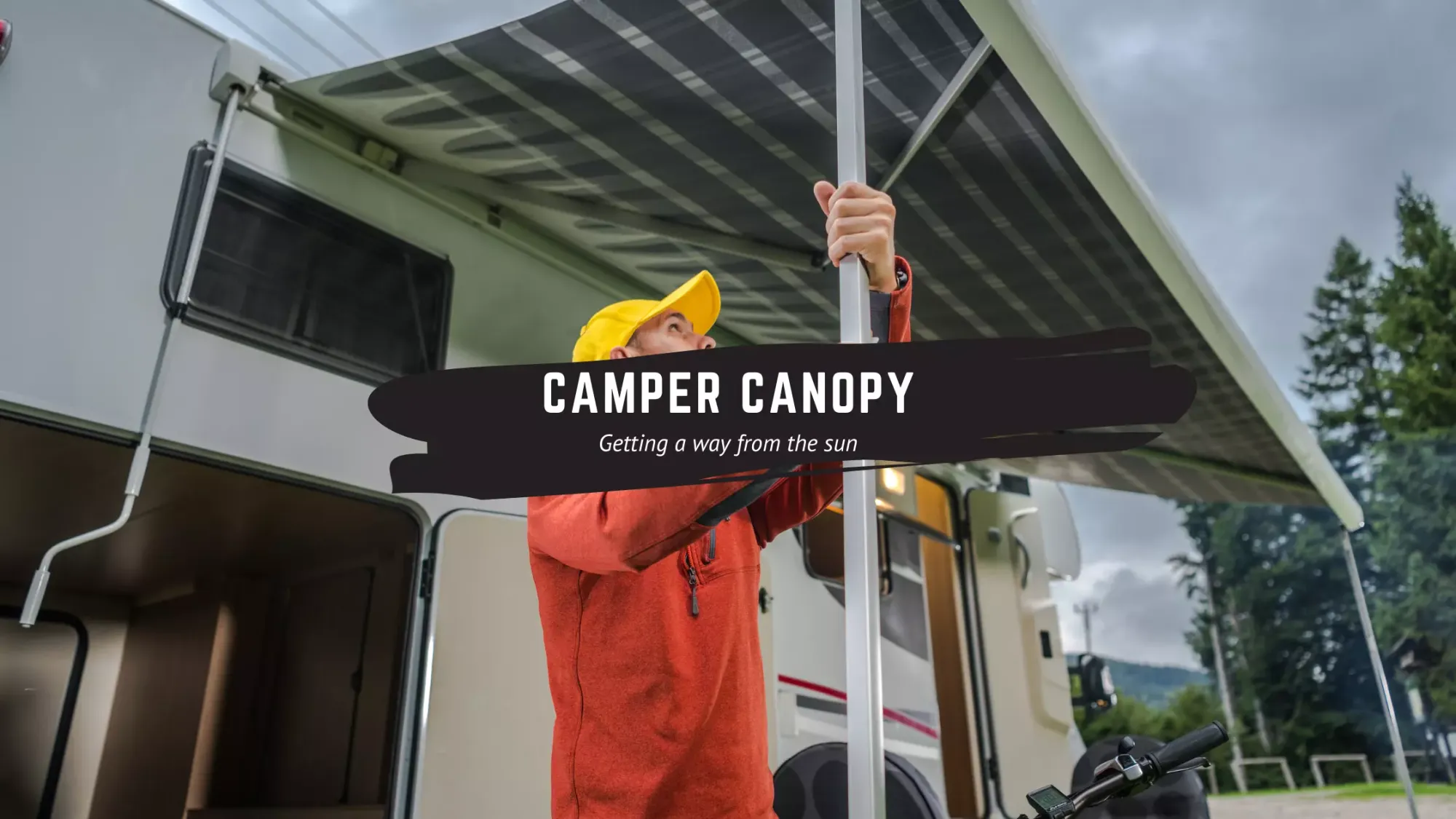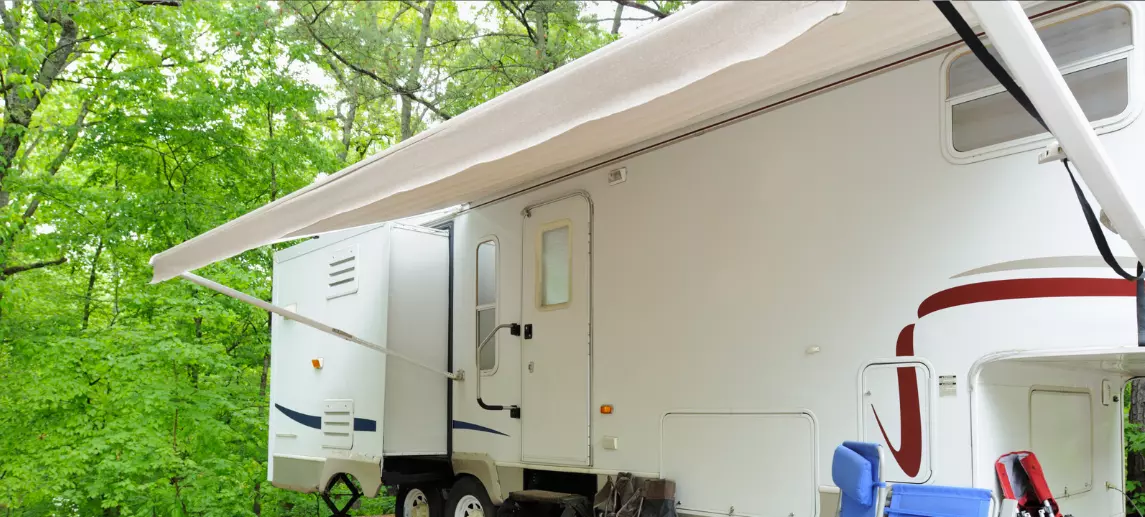Guide to RV and Camper Canopies and Other Sun Shades

We're tackling an essential subject for any motorhome enthusiast - the RV and camper canopies and sun shades. Whether you're a seasoned road tripper or just starting on your RV journey, knowing the ins and outs of these practical and necessary accessories can enhance your outdoor experience. So buckle up as we explore the realm of sun protection for your RVs and campers.
What are RV and Camper Canopies and Sun Shades?
First, let's define what we mean by RV and camper canopies and sun shades. In simple terms, these are outdoor extensions that provide shade and protection against different weather elements, primarily the sun. Canopies are generally larger, offering extended coverage and space for outdoor living, while sun shades are typically smaller, designed to cover windows or doors and protect the interior from heat and UV rays. Both are essential for a comfortable camping experience.

Why are They Important?
You may be wondering, why fuss about sun protection for your RV or camper? Isn't the whole point of being on the road to embrace the great outdoors? While that's true, having an effective sun protection system brings several benefits:
- Comfort: In summer, temperatures inside an RV or camper can skyrocket, turning your mobile home into a literal oven. Proper sun shades can reduce internal temperatures, making your living space more comfortable.
- UV Protection: Prolonged exposure to UV rays can damage your skin and your camper's interior. Canopies and sun shades block UV rays, offering protection to you and your mobile home.
- Energy Efficiency: By reducing the internal temperature, sun shades can help decrease the need for air conditioning, thereby saving energy and costs.
- Expanded Living Space: With an RV or camper canopy, you can extend your living space outdoors, allowing you to enjoy nature while still under the comfort of a shade.
Choosing the Right Canopy or Sun Shade for Your RV or Camper
Now that you know why canopies and sun shades are indispensable, let's talk about how to choose the right ones. The decision depends on several factors, including your RV or camper size, where you plan to travel, and your personal preferences.
- Material: Look for durable materials that can withstand different weather conditions. Polyester and polyethylene are commonly used due to their UV-resistant and waterproof properties.
- Size: The size should match your RV's or camper's dimensions. Remember, a canopy that's too small won't provide adequate shade, while one that's too big may not fit properly.
- Installation: Some canopies and sun shades require complex installation processes. If you're a DIY enthusiast, this may not be an issue, but for those who prefer simplicity, consider options that are easy to set up and dismantle.
- Portability: Given the mobile nature of RVing and camping, opt for a lightweight and compact canopy or sun shade that's easy to transport and store.
Canopies and sun shades for RVs and campers come in various types, each offering its own unique advantages. Here's a rundown of some of the most common types you'll come across:
Roll-Up Canopies: Also known as retractable awnings, these canopies are attached to the side of your RV or camper. They are typically made from durable material like vinyl or acrylic and can be rolled out or retracted as needed. Some models are manual, while others offer automatic features, which can be convenient but also more expensive.
Slide-Out Canopies: These are designed to fit over the slide-out sections of an RV. Their main function is to protect the roof of the slide-out from debris and water buildup, but they can also provide some shade.
Window Awnings or Shades: These smaller awnings are designed to provide shade for the windows of your RV or camper, helping to keep the interior cool. They can be fixed or retractable, depending on the model.
Door Awnings: Door awnings are small canopies designed to protect the entrance of your RV or camper from the elements. Besides providing shade, they can keep rain or snow away from the doorway.
Screen Room Canopies: These are essentially canopies that come with attachable screens. They provide an enclosed space where you can enjoy the outdoors while being protected from insects, the sun, or mild weather conditions.
Portable Canopies or Gazebos: These standalone structures are not attached to the RV or camper but provide a shaded area in your campsite. They're great for larger gatherings or when you need a separate space for outdoor cooking or dining.
Sunblocker or SideBlocker Shades: These accessories attach to the sides of an existing canopy. They're designed to block sun that comes in from the side, providing additional shade and privacy.
Windshield Sun Shades: These are designed to cover the windshield of your RV when parked. They block sunlight from heating up the interior of your RV, and also provide privacy.
Interior Sun Shades: These shades are installed on the inside of your RV or camper windows. They can be rolled down to block the sun, helping to regulate the temperature inside your vehicle.
When choosing the type of canopy or sun shade for your RV or camper, consider your specific needs, such as the size and model of your RV, where and when you'll be using it, and your budget. Each type has its own advantages and is suited to different situations and uses.
Canopy Installation
RV canopies, also known as awnings, are not typically hard to install, but the difficulty can vary based on the type of canopy, the size, and the specific design of your RV. Here are a few general steps you'd need to follow to install most types of RV canopies:
Unpack and Understand the Instructions: Start by unpacking your canopy and reading the manufacturer's instructions thoroughly. Every canopy is a bit different, so it's important to understand the specific steps required for your model.
Mount the Hardware: Most canopies come with brackets or other hardware that need to be mounted to the side of the RV. Make sure to measure and mark the locations accurately before you start drilling.
Install the Roller Tube: The canopy fabric is typically wound around a roller tube, which needs to be installed in the brackets or hardware you've just mounted. Depending on the size of the canopy, you may need a second person to help with this step.
Attach the Fabric: Once the roller tube is in place, the fabric can be extended and attached to the RV. This might involve sliding it into a track on the side of the RV, or it might involve securing it with separate ties or straps.
Check and Secure: After everything is installed, check that the canopy extends and retracts smoothly, and that all of the hardware is secure. Adjust as necessary.
Some things to keep in mind:
- While the process isn't overly complicated, it can be physically demanding, especially for larger canopies. It's often a two-person job.
- If you're not comfortable with drilling into your RV or lifting heavy objects, you might want to consider professional installation.
- Always follow the manufacturer's instructions. The steps mentioned above are only a general guideline. Different models may require different steps.
- Safety should be your top priority. Ensure you use the correct tools and take necessary precautions to avoid accidents.
The installation of an RV canopy can be a DIY project if you're handy and have a bit of patience. But there's no harm in hiring a professional if you're unsure – the important thing is to get the job done correctly so you can start enjoying your new canopy.
Top Picks for RV and Camper Canopies and Sun Shades
Having explored what to look for when shopping, let's dive into some of the top picks in the market as of 2023:
- Carefree Vacation'r Screen Room: This one's a combination of a canopy and a sun shade. It's perfect for those looking for a temporary outdoor extension of their RV or camper. Made from durable material, it's easy to install without any drilling required.
- Shade Pro RV Vinyl Awning Replacement: For those in need of a canopy replacement, this product is a standout. Its heavy-duty vinyl fabric is designed to resist weathering and fading, offering years of reliable use.
- EZ ZipBlocker by Carefree: As for sun shades, this one takes the cake. You can attach it to your existing RV awning for extra sun and wind protection. Plus, it's available in various sizes to cater to different needs.
- Camco SunShield Reflective Window Cover: This sun shade is ideal for reducing heat in your camper's interior. It's designed to fit various window sizes and is easy to install and remove.
Conclusion
In the vast and exciting world of RVing and camping, comfort and protection are crucial. Canopies and sun shades are a key part of that equation. They shield you and your mobile home from harsh sun rays, cut down on energy use, and offer an expanded, shaded outdoor space.
So, next time you're ready to hit the road, ensure your RV or camper is well-equipped with a quality canopy or sun shade. It's not just about enduring the journey—it's about enhancing your overall experience, one shaded, comfortable moment at a time.
Safe travels, my fellow wanderers! Stay cool, stay shaded.